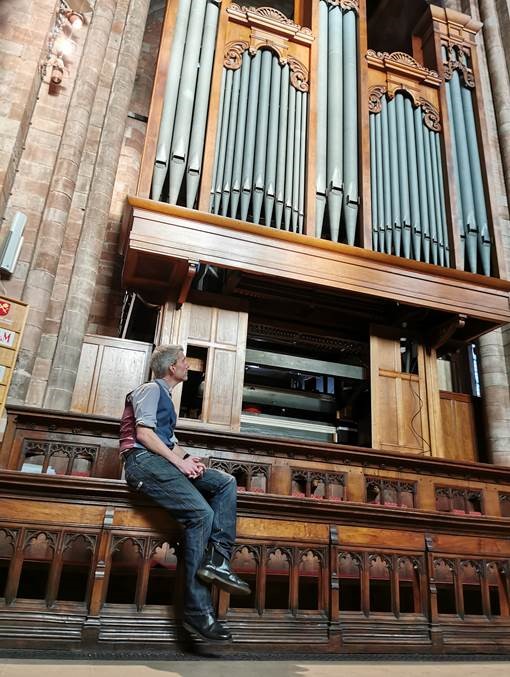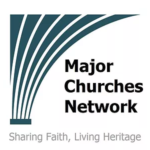Shrewsbury Abbey is fortunate in having a fine William Hill and Sons organ, installed in 1911. The organ was designed for the restored and extended Abbey (John Loughborough Pearson’s 1880s and 1890s work) and was also designed to fit into a large space to the north side of the new Chancel. Hill was one of the two foremost organ builders of the time and his organs are found in many of the UK’s cathedrals and churches.
This was the second organ installed in the Abbey. An earlier organ by William Gray, dating from 1806, had been in use for over 100 years. The Hill organ replaced this instrument, but none of the pipework was reused.
Hill’s 1911 scheme for the new organ was not completed. Key stops were omitted, and there was no front casework. Winding initially was manual. The actions were entirely tubular pneumatic, the latest technology of the day.
Work since 1911
Over the past 100 years, various changes and additions were made, of varying quality and appropriateness.
- In 1921 the hand blowers were replaced by a large electric blower, which itself was replaced in 2012
- Pipework was added in 1937 and 1945 – all good quality, but not as Hill intended. Chancel facing casework was also added (by an Abbey Foregate builder) in 1945
- Changes to the choir division were made in 1958, and these effectively muffled sound egress
- Also in 1958 there was the last major clean of the whole organ
For over 100 years the organ was missing some key stops. It was not sufficiently powerful for the vast space of this building and the east face of the organ was also clearly incomplete and ugly.
Work was still needed
Many schemes for the renovation and completion of this potentially fine organ were advanced over many years. None of these were progressed, although fund raising had begun. Meanwhile the organ’s problems were increasing, but the quality of the organ’s tone led many people to ask whether there was a need to do any work at all. By the 2010s, the actions were increasingly failing, winding systems were leaking, the whole organ was overdue a thorough clean, woodworm infestations were increasing, and it was still lacking the punch it needed. But it was realised that, completed and renovated, this organ would potentially be magnificent, of regional and even national importance.
The 2020 Scheme of Work
Carried out by GO Organbuilders, the scheme of work was to:
- Convert the original tubular pneumatic actions to electro-pneumatic
- Electrify and restore the console to original condition
- Complete Hill’s 1911 stop specification with minimal appropriate additions
- Restore and lift reservoirs/blowers above head height to gain storage space, and adapt/replace wind trunking
- Erect a new east end platform for the missing pipework and raised winding
- Clean and repair all existing pipework; eradicate woodworm infestations
- Reduce the choir division expression box back to its 1911 size, enclosing only the two solo reed stops
Beginning in March 2020, this was the most significant work on the organ since its original installation. The work was completed 18 months later and the organ was rededicated on Sunday 17th October 2021
The organ has three keyboards and pedals, and 43 speaking stops. There are 2400 pipes, 450 more than in the unfinished organ. The electrified console has a modern multi-channel control system of general and divisional pistons, but the outward appearance of the keyboards and stop jambs is very little different. Where possible, original materials have been retained, but restored to original condition.
Specification
This is the specification of the completed organ. After nearly 110 years, this scheme has finally realised Hill’s 1911 specification, with minimal change. Additions during the 2020/21 work are shown in red; stops previously present in the organ in black.
Pedal Organ (30 notes)
Double open 32*
Open metal 16*
Open wood 16’
Bourdon 16’
Violone 16’
Octave 8’
Base flute 8’
Violoncello 8’
Contra trombone 32’
Trombone 16’
Trumpet 8’
Swell organ (61 notes)
(enclosed)
Bourdon 16’*
Open diapason 8’
Stop’d diapason 8’
Salcional 8’
Voix celestes 8’
Principal 4’
Flute 4’*
Fifteenth 2’
Mixture 3rks
Oboe 8’
Double trumpet 16*
Trumpet 8*
Clarion 4*
Great Organ (61 notes)
Double diapason 16’
Open diapason no 1 8’
Open diapason no 2 8’
Hohl flute 8’
Principal 4’
Harmonic flute 4’
Twelth 2 2/3’
Fifteenth 2’
Mixture 3rks
Posaune 8’
Choir organ (61 notes)
(Reeds only enclosed)
Dulciana 8’
Viol di gamba 8’
Lieblich Gedact 8’
Saube Flute 4’
Nazard 2 2/3’
Piccolo 2’
Clarinet 8’
Orchestral oboe 8’
Tuba 8’ (Not enclosed)
Couplers
Great to pedal
Swell to pedal
Choir to pedal
Swell to great
Swell to choir
Choir to great
Great to choir
Great and pedal combs
Swell pistons on toe levers
Generals on choir pistons
Pistons
4 thumb pistons to swell
4 thumb pistons to great
4 thumb pistons to choir
Stepper + and – pistons
Set and cancel pistons
Toe levers
4 toe levers to swell
4 toe levers to pedal
Great to pedal
Swell to great
Stepper + and – toe levers
A fuller version of this specification, with more detail of the heritage of each of the stops:
Click here to download a PDF containing detailed specifications of the organ
As will be seen from the detailed specification, significant additions to the swell organ and two additional pedal stops (all noted with * in the red text above) are from the unplayable old organ in St Bartholomew the Great, London, and the Abbey thanks the Rector and Wardens for their huge generosity.
Organ Fund Appeal And Donations
The organ work is now complete, but our fund raising has still a little further to go.
A huge amount has already been raised. Much of this is through donations, concerts and recitals, sponsored fund raising and pipe sponsorship; over many years we have raised nearly £120,000, a superb achievement through the efforts and generosity of a lot of individuals.
We are also fortunate to have benefited from grants from a number of trusts and other organisations, which as at October 2021 include:
The whole 2020 scheme will cost the Abbey around £200,000. Years of fund raising together with donations/grants from funds and charities has covered nearly all of this cost, however donations are still most welcome.
Allchurches Trust
Garfield Weston Foundation
Lord Leverhulme’s Charitable Trust
The Owen Family Trust
Shropshire Historic Churches Trust
Shropshire Masonic Charitable Association
Edward Cadbury Charitable Trust
The John Pilling Trust
The Millichope Foundation
The Prince of Wales Charitable Trust
The Williams Church Music Trust
These grants amount to £76,000.
In total therefore we have already raised £196,000.
Once all the bills have been paid, our total project costs will amount to £228,000.
Therefore there is still £32,000 to raise. The PCC is underwriting that gap but our aim is to continue to raise money so that we can cover the whole project cost through donations and grants. Once that target has been reached, fund raising will continue so we can maintain the organ to the necessary high standard.
How you can help
Individual donations can be made direct to the Abbey’s Restoration Account at the RBS, sort code 16-31-23, account number 10129838. If you are able to Gift Aid your donation – forms are available in the Abbey – that will increase the amount of your donation by 25%.
You can also sponsor one or more of the smaller organ pipes – further details are on the Abbey’s web site at https://www.shrewsburyabbey.com/music/sponsor-an-organ-pipe/.
Or you could consider sponsoring one of the largest pipes in the organ – there are 12 Contra Trombone 32’ pipes, and each can be sponsored for £1,000. Details are also on the Abbey web site through the link above.
What’s Next……..?
Now the organ work is finished, and our formal opening recital held, we will continue what we have begun.
There will be regular organ recitals and concerts on Saturdays throughout the year. Keep an eye on the web site for news of what’s coming up, or give us your email address so we can update you directly.
We also want the organ to be widely used. It is available for booked practice. We encourage visiting organists to come and play – either as one of our visiting organists, or as visitors during the week – just contact us on the email address organistshrewsburyabbey@gmail.com.
We also want to encourage students, music teachers and colleges to book the organ for lessons, practice or concerts. Just contact the Abbey office or the above email address.
As part of our commitment to developing musical skills and interest in younger people, we are currently on the look-out for a new organ scholar. Our previous scholars have all gone on to study music in further education. Good keyboard and sightreading skills are essential but we will help you learn accompaniment and choir practice skills. Contact either the Director of Music or our organist for more information.
We also hope visiting choirs will want to come here to sing services, and experience our choral tradition and potential first-hand – email musicshrewsburyabbey@gmail.com for more information.
Here is a selection of music played on the Hill organ on Mothering Sunday 2020, just hours before work to dismantle the organ began. The music was recorded live by Nigel Pursey on his mobile phone.
At the Close of the Day – Healey Willan











